Definition. Let ${\bf u}=(u_1,u_2,u_3)$ and ${\bf v}=(v_1,v_2,v_3)$. Then the cross product ${\bf u}\times {\bf v}$ is defined by \begin{equation}\label{eq:crossprod}{\bf u}\times{\bf v}=(u_2v_3-u_3v_2,u_3v_1-u_1v_3,u_1v_2-u_2v_1)\end{equation} The cross product can be also written as the determinant \begin{equation}\label{eq:crossprod2}{\bf u}\times{\bf v}=\begin{vmatrix}{\bf i} & {\bf j} & {\bf k}\\u_1 & u_2 & u_3\\v_1 & v_2 & v_3\end{vmatrix}\end{equation} One can calculate the determinant as shown in Figure 1. You multiply three entries along each indicated arrow. When you multiply three entries along each red arrow, you also multiply by −1. This is called the Rule of Sarrus named after a French mathematician Pierre Frédéric Sarrus.
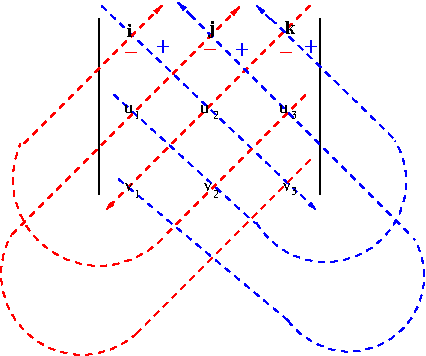
Unlike the dot product, the outcome of the dot product is a vector. Also unlike the dot product, the cross product is anticommutative i.e. $${\bf u}\times{\bf v}=-{\bf v}\times{\bf u}$$ Furthermore, ${\bf u}\times{\bf v}$ is orthogonal to both ${\bf u}$ and ${\bf v}$. This can be seen by showing that $$({\bf u}\times{\bf v})\cdot{\bf u}=({\bf u}\times{\bf v})\cdot{\bf v}=0$$ The cross product tells us about the orientation of the plane containing two vectors ${\bf u}$ and ${\bf v}$ as shown in Figure 2.
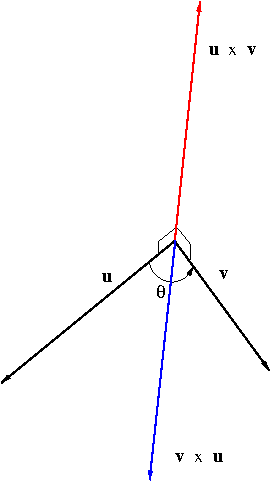
Theorem. If $\theta$ is the angle between ${\bf u}$ and ${\bf v}$ ($0\leq\theta\leq\pi$), then \begin{equation}\label{eq:crossprod3}|{\bf u}\times{\bf v}|=|{\bf u}||{\bf v}|\sin\theta\end{equation}
Proof. It would require some work with algebra but one can show that $$|{\bf u}\times{\bf v}|^2=|{\bf u}|^2|{\bf v}|^2-({\bf u}\cdot{\bf v})^2$$ This, along with ${\bf u}\cdot{\bf v}=|{\bf u}||{\bf v}|\cos\theta$, will lead to \eqref{eq:crossprod3}.
From \eqref{eq:crossprod3}, we can easily see that two nonzero vectors ${\bf u}$ and ${\bf v}$ are parallel if and only if ${\bf u}\times{\bf v}=0$.
The standard basis vectors ${\bf i}$, ${\bf j}$, ${\bf k}$ satisfy the following cross products: $${\bf i}\times{\bf j}={\bf k},\ {\bf j}\times{\bf k}={\bf i},\ {\bf k}\times{\bf i}={\bf j}$$
The following theorem summarizes the properties of the cross product.
Theorem. Let ${\bf u}$, ${\bf v}$, and ${\bf w}$ be vectors and $c$ a scalar. Then
- ${\bf u}\times{\bf v}=-{\bf v}\times{\bf u}$
- $(c{\bf u})\times{\bf v}=c({\bf u}\times{\bf v})={\bf u}\times(c{\bf v})$
- ${\bf u}\times({\bf v}+{\bf w})={\bf u}\times{\bf v}+{\bf u}\times{\bf w}$
- $({\bf u}+{\bf v})\times{\bf w}={\bf u}\times{\bf w}+{\bf v}\times{\bf w}$
- ${\bf u}\cdot({\bf v}\times{\bf w})=({\bf u}\times{\bf v})\cdot{\bf w}$
- ${\bf u}\times({\bf v}\times{\bf w})=({\bf u}\cdot{\bf w}){\bf v}-({\bf u}\cdot{\bf v}){\bf w}$
The products in 5 and 6 are called, respectively, a scalar triple product and a vector triple product.
From Figure 3, we see that \begin{equation}\label{eq:areaparallelogram}|{\bf u}\times{\bf v}|\end{equation} is equal to the area of the parallelogram determined by ${\bf u}$ and ${\bf v}$.
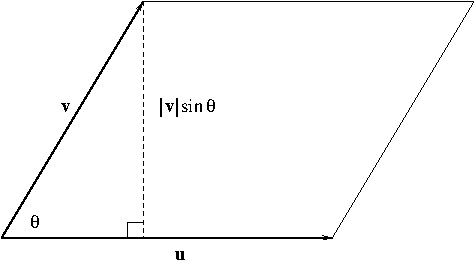
Example. Find a vector perpendicular to the plane that passes through the points $P(1,4,6)$, $Q(-2,5,-1)$, and $R(1,-1,1)$.
Solution. The vectors $\overrightarrow{PQ}=(-3,1,-7)$ and $\overrightarrow{PR}=(0,-5,-5)$ lie in the plane through $P,Q,R$. So the cross product $$\overrightarrow{PQ}\times\overrightarrow{PR}=(-40,-15,15)$$ is perpendicular to the plane.
Example. Find the area of the triangle with vertices $P(1,4,6)$, $Q(-2,5,-1)$, and $R(1,-1,1)$.
Solution. In the previous example, we found $\overrightarrow{PQ}\times\overrightarrow{PR}=(-40,-15,15)$ and by \eqref{eq:areaparallelogram} we know that $|\overrightarrow{PQ}\times\overrightarrow{PR}|=\sqrt{(-40)^2+(-15)^2+{15}^2}=5\sqrt{82}$ is the area of the parallelogram determined by the two vectors $\overrightarrow{PQ}$ and $\overrightarrow{PR}$. The area of the triangle with vertices $P$, $Q$, and $R$ is just the half of the area of the parallelogram i.e. $\frac{5}{2}\sqrt{82}$.
From Figure 4, the volume of the parallelepiped determined by ${\bf u}$, ${\bf v}$, and ${\bf w}$ is $$V=|{\bf v}\times{\bf w}||{\bf u}|\cos\theta={\bf u}\cdot({\bf v}\times{\bf w})$$ In Figure 4, the vectors ${\bf u}$, ${\bf v}$, and ${\bf w}$ are positioned well enough so that the triple scalar product ${\bf u}\cdot({\bf v}\times{\bf w})$ is positive but depending on how they are positioned, it could be negative. Since the volume always has to be positive, it is given by \begin{equation}\label{eq:volumeparallelepiped}V=|{\bf u}\cdot({\bf v}\times{\bf w})|\end{equation}
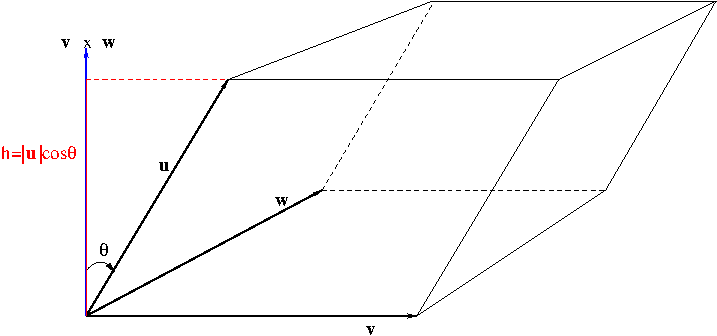
The scalar triple product ${\bf u}\cdot({\bf v}\times{\bf w})$ can be written nicely by the determinant \begin{equation}\label{eq:scalartripleprod}{\bf u}\cdot({\bf v}\times{\bf w})=\begin{vmatrix}u_1 & u_2 & u_3\\v_1 & v_2 & v_3\\w_1 & w_2 & w_3\end{vmatrix}\end{equation} The calculation of the determinant can be done by the rule of Sarrus shown in Firgure 1.
Example. Determine if ${\bf u}=(1,4,-7)$, ${\bf v}=(2,-1,4)$, and ${\bf w}=(0,-9,18)$ are coplanar.
Solution. From Figure 4 above, one can easily see that the three vectors ${\bf u}$, ${\bf v}$ and ${\bf w}$ are coplanar (i.e. they are in the same plane) if and only if $\theta=\frac{\pi}{2}$ if and only if ${\bf u}\cdot ({\bf v}\times{\bf w})=0$. \begin{align*}{\bf u}\cdot ({\bf v}\times{\bf w})&=\begin{vmatrix}1 & 4 & -7\\2 & -1 & 4\\0 & -9 & 18\end{vmatrix}\\&=0\end{align*} Therefore, ${\bf u}$, ${\bf v}$ and ${\bf w}$ are coplanar.
The notion of the cross product can be used to describe physical effects involving rotations such as the circulation of electric/magnetic fields or fluids. Here we discuss the torque as a physical application of the cross product. Look at Figure 5.
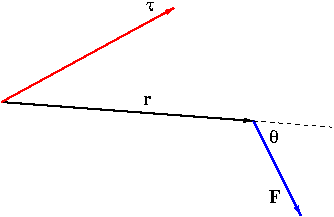
Assume that a force ${\bf F}$ is acting on a rigid body at a point given by a position vector ${\bf r}$. The resulting turning effect ${\bf\tau}$, called the torque, can be measured by \begin{equation}\label{eq:torque}{\bf\tau}={\bf r}\times{\bf F}\end{equation}
Example. A bolt is tightened by applying a 40 N force to a 0.25 m wrench as shown in Figure 6. Find the magnitude of the torque about the center of the bolt.
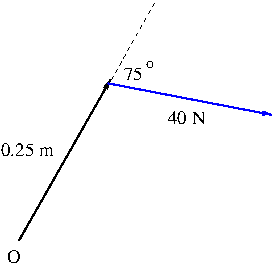
Solution. The magnitude of the torque is \begin{align*}|{\bf\tau}|&=|{\bf r}\times{\bf F}|=|{\bf r}||{\bf F}|\sin 75^\circ=(0.25)(40)\sin 75^\circ\\&=10\sin 75^\circ\approx 9.66\ \mathrm{Nm}\end{align*}
Examples in this note have been taken from [1].
References.
[1] Calculus, Early Transcendentals, James Stewart, 6th Edition, Thompson Brooks/Cole
